Navigation auf uzh.ch
Navigation auf uzh.ch

Ausstellung entwickelt von Wiktoria Furrer, Carla Gabrí, Ekaterina Kurilova-Markarjan, Nastasia Louveau, María Ordoñez, Dimitrina Sevova, Anja Nora Schulthess, Nika Timashkova, Valentina Zingg und Artur Żmijewski.
Das Seminar "How to teach Art" wurde im Rahmen des Doktorandenprogramms "Epistemologien ästhetischer Praktiken" (Collegium Helveticum) veranstaltet.
In Kooperation mit dem Zentrum Künste und Kulturtheorie (ZKK), dem ERC-Projekt "Performance Art in Eastern Europe", dem SNF-Projekt "Exhibiting Film" (UZH), dem Seminar für Filmwissenschaft UZH, dem Slavischen Seminar UZH und dem Institut für Theorie ZHdK. Gefördert von swissuniversities.
Planned essay will be titled "How to Teach Art". I expect it to be a manual explaining on the certain way how to teach art. There are of course different strategies how to educate people – I'd like to present my subjective opinion about it.
My idea is based on the "process of the alchemist" – I will use metaphor of the alchemist to create education strategy. The goal of the alchemist is to create active formula / object which has certain ability to transform material / substantial reality. In the alchemy it's a philosophical stone which creates perfect substances out of ordinary ones. This is good metaphor of the art piece – which should be exactly this active / magic formula able to transform emotions or thoughts of the viewer. In a wider sense it could transform social reality or even politics.
Using the metaphor of the "process of the alchemist" would be able to elevate mysterious process of making art on to much more rational level. There are 3 phases of the process:
I’d like to teach students this psychological background of artistic activity and let them go through the "process of the alchemist" when it is supervised. The "process of the alchemist" is also the way of looking for the answer. Answer is the equivalent of the art work.
There is a complementary path of education which I'd like to test. It's based on much more rational process – focused on the historical modifications of the human perception and tools built to represent reality.
It is also divided on 3 parts:
This path would be based on the using of the old film equipment and research around the perception. Students could understand evolution of the human perception as historical process – again in 3 steps:
Quick journey through decades could offer students deeper understanding of the human wish to represent reality. The content of the exercises could be designed in contrary to the rational explanation of the certain cinema tool – and could be focused on intuitive use of certain camera. All exercises would be discussed and developed together with students – and later on used as examples to illustrate the essay "How to Teach Art". Both methods could be "tested" using certain exercises.